It might be helpful if more of us (myself included) who post hiking photos or write about our hiking experiences told more stories about when and why we turn back sometimes prior to reaching our planned destinations.
I mention this in part because two people died this past week in Angeles National Forest. The first, Daniel Nguyen, died falling from the Devil’s Backbone Trail near Mt. Baldy last Tuesday. The second, Dong Xing Liu, died falling in the Icehouse Saddle area last Saturday. Lieu’s wife and ten other people were airlifted off the mountain as well. Four of those people suffered injuries including a broken hip and broken ribs. I followed this link from a post from Modern Hiker on Facebook to learn more about one of Saturday’s rescues. Another hiker, Jason, suffered multiple injuries including a fractured skull and eye socket in a fall from Timber Mountain on January 23rd. As far as I can tell that has only been reported on a gofundme page set up by his brother-in-law Andrew (who posted on my Facebook page) and shared on other social media. Last Wednesday, I played a minor role in a rescue where a hiker needed to be airlifted out of a gully in Icehouse Canyon (he had a broken ankle/leg and should be OK). I was merely one of the several people helping the first helicopter locate the hiker. I also helped walk his dogs down to the trailhead after one of the rescuers shepherded them back up the steep mountain from the gully to the trailhead–which there’s no way I could have accomplished. As far as I can tell, that rescue has only been reported on social media by myself and one of the other hikers (Bonnie) who helped with the dogs. I wonder how many other rescues happen that don’t get reported in the popular press. I’m guessing more than I want to know about. I called the Mt. Baldy Visitor’s Center this morning and verified that the Icehouse Canyon Trail is temporarily closed. With great hesitation, the person I spoke with said Baldy Bowl and Devil’s Backbone are still open. However, it appears that has changed. About an hour later the US Forest Service posted “Be Advised: Until further notice, all Mt. Baldy Trails have been closed due to icy conditions and severe risk of injury.”
Of course, there’s a lot of criticism floating around on social media. Criticism of the hikers, criticism of the Forest Service for not closing the trails down sooner and also for closing them down at all–the Forest Service really can’t win on that issue. I’m not interested in those discussions. Daniel Nguyen died trying to help someone else. People fall on dry flat perfectly maintained walkways wearing appropriate shoes all the time. I’m thankful I’ve never needed to be rescued but that doesn’t mean I won’t no matter how reasonably cautious I think I’m being. To those who’ve been so critical and condescending, the story of Ranger Randy Morgenson’s death in the High Sierra’s might help slow down a desire to judge and spew out pronouncements. Also, I wasn’t part of the decision-making process the Forest Service used to temporarily close the trails. Without being part of that process, I don’t know all the issues they were dealing with when they decided to make those closures.
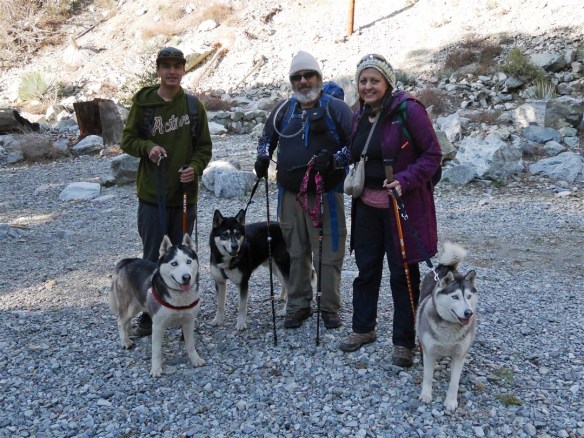
Help came quickly with hiker’s Anthony and Bonnie ending their hikes early to help me bring the dogs down. Two members of the forest service (who were great) met us partway down and helped as well.
I rarely see first-hand accounts of people deciding to turn back earlier than planned on a hike. I certainly don’t write about that every time I decide to turn back at an appropriately early time for me. My turnaround point may be too early or too late for others. However, sharing my decision-making process may help others think through when they might want to choose to call it a day. At the same time, I’d like to underscore that unavoidable accidents do happen. Sometimes a slip is just that; no amount of preparation, gear choice, or reasonable level of caution would prevent it.
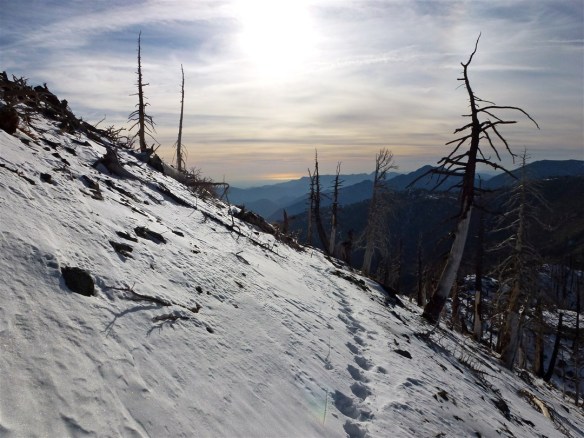
I had already hiked to Mt. Hawkins in snow before on November 9, 2011. Note the post holing track I left on my way up. No sinking into the icy snow occurred on my way up to Windy Gap on this year’s attempt.
I’ve been on three snow hikes this year. I’ve needed to turn back early on two of them–one was last Wednesday when I turned back just above the junction with the Chapman Trail. On January 25th, I headed up the PCT expecting to go to Mt. Hawkins, microspikes on, using my trekking poles, and carrying snowshoes in my backpack. I had already hiked up to Mt. Hawkins in the snow back in November of 2011 and thought this would be a perfect day for a repeat trip.
Heading up from Islip Saddle, my microspikes worked great, the trail was comfortably wide for me, and it was a gorgeous day. By the time I got midway between the lower junction with the road to Little Jimmy Campground and the campground itself, the trail began to narrow. Frozen postholes and other clues showed the snow to be over a foot deep in some areas. However, the hard icy conditions prevented me from sinking in. I had never been in conditions like that before. My previous experience with snow that deep meant it was time for the snowshoes because I’d be sinking in. The narrow flat ledge remained wide enough to remain at a reasonable distance inside the edge of my comfort zone. At my skill level, though, I needed to be laser-focused, paying attention to my feet instead of the fantastic views around me, and go real slow in many places. When I reached Windy Gap, I wasn’t physically tired or winded at all, but, I was starting to feel mentally drained. The view up the PCT looked like something I could handle physically. At the same time, I knew there would be lots of areas where I’d need to be super focused mentally and I wasn’t sure I’d be up to the task of doing that. The presence of tracks indicating others had made it higher up didn’t matter, the fact that I had made it as far as Mt. Hawkins in the snow in the past didn’t matter. What mattered was how I felt at that moment, and I felt a little apprehensive. I was concerned about the icy conditions and whether or not I’d know in time if I got too tired to maintain the focus required to descend safely. Unlike the snow that gives, allows one to sink in, and slows one down; this icy hard stuff meant one small slip and I could find myself accelerating down the mountain.
After deciding not to go to Mt. Hawkins, my attention turned to Mt. Islip. I wasn’t ready to be done for the day and I’d seen a few photos on Instagram of people who had recently made it to Mt. Islip. Well, there wasn’t any form of ledge or trace of trail present. That may be no problem for some people better trained and more experienced than I, but I need some form of a trail/ledge or I feel too unsteady to move forward. So, that wasn’t an option. I sat on the bench, ate lunch, enjoyed the view and got ready to focus on making it down from where I was.
By the time I got to Little Jimmy Campground, I decided I needed another break mentally. This reinforced in me that I made the right decision back at Windy Gap. The trek down from Windy Gap wasn’t even that tough, but, I recalled most of my need to achieve laser-focus was between the campground and the junction with the road. Then I thought about the fact I had never taken the road before. Surely it was wider and much safer. What a relief, the road was perfect. I could just relax, enjoy the rest of my day, and not worry about a few patches of thin and icy trail. From above, I was surprised to see how close the road follows the PCT as I looked down on it. In many ways, it’s just a wider version yielding almost identical views. This road would be great for snowshoeing on another day. In fact, I can’t imagine a scenario where I will take the PCT instead of this road up to Little Jimmy in the snow in the future. A key thing I’ll remember moving forward is the sense of relief I felt when I got to the road. While I know I would have turned back on my way up the mountain if the trail disappeared or got much narrower on the way to Little Jimmy Campground, that sense of relief made me realize the importance of tracking my mental tiredness–especially in areas where there is no real margin for error. How many times have I turned back later than I should have and just got lucky? How would I even know? Accidents happen where there’s nothing one could have done to prepare and there’s nothing one could really do differently (which is why I carry a device that can send messages for help via satellite and $100K of search and rescue insurance). Knowing when to turn back on a hike is a fundamental part of hiking that we hikers should also be training for. I hope other’s will share their stories of turning back as they may provide some inspiration for this form of training as hike reports do in finding trails. One person’s accident is another person’s bad decision making and vice versa. I think there are too many factors to judge whether something is a misfortune or a mistake from afar and that there’s really no point in doing so. It’s up to us to determine what we shouldn’t do. Lot’s of people could have easily made it to Mt. Hawkins on the day I clearly shouldn’t have tried. I’m happy I turned back!


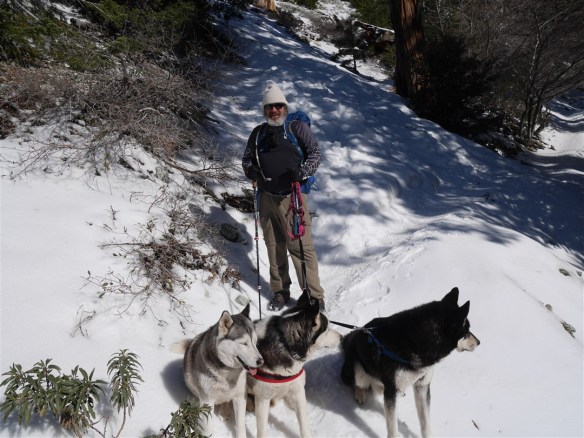
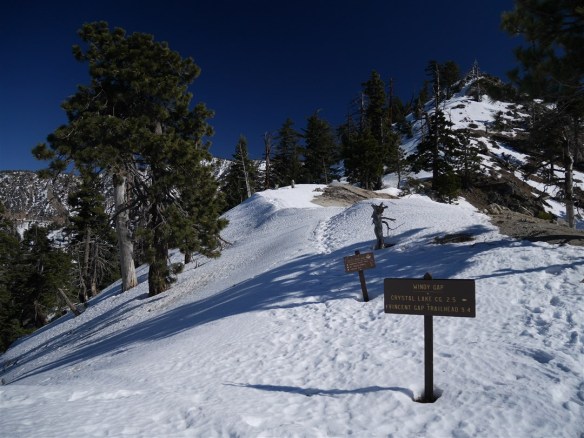
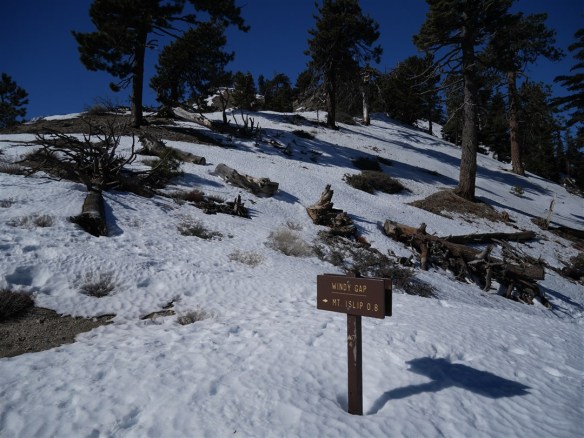

Great article. Thanks for sharing thoughts. Safety SHOULD be everyone’s priority.👌🏽👊
LikeLike
A great reminder, thanks.
LikeLike
I’m glad you mentioned about people being critical and condescending. I wish more people would, “judge not…” and mentioning that people could fall on flat surfaces is on point. Accidents can happen anywhere. But, I agree with your perspective and for it to be applied anywhere. Listen to yourself and trust that red flag of doubt waving in your head. Don’t ignore it, trust your gut instincts.
LikeLike
Diana,
We make all make judgments. Saturday in Ice House Canyon was all about judgments. If you go on the San Diego for to learn how to drive with no experience both you and your instructor made a judgment that puts both of you at unnecessary risk.
Red flags in your head…these do not exist to many, read the write up at wildcalendar.com. There were no red flags in these “high end hikers” head, even after two in the group were severely injured.
Yes, you can fall and get hurt on a flat surface and get hurt, I have done that myself on the ramp at the PS Tram. However, experience…I have have tons of it, in Ice House Canyon on snowy and icy days tell me what happen in San Antonio Canyon the last two weeks are errors in judgment.
Many of us with extensive winter experience have been predicting what happen the last to weeks. We wish our predictions did not come true. People go up these trails and slopes with gear that is not designed for what they want to accomplish. My friends and I have told many, to turn around they are not safe but they keep on going with their Microspikes and poles, where ice axe, crampons, helmet and most of all knowledge of conditions. We are ignored for various reasons.
More will die this winter because they don’t know what they are getting themselves into. I have had five people slide by me in the area Mr. Lui died, 4 got a free helicopter ride to Arrowhead Regional Medical Center, the other had a face that looked like hamburger meat. All doing things they should not have been doing…another judgment on my part.
As for criticism, you cannot grow without introspection and outside criticism. You must be able to defend your actions. I have made many mistakes in these mountains and I write about them. I do not mind being called a dumbass when I do dumbass things…I want to learn. My dumbass things have cost me very little, a couple of sprained ankles and big L tear in a pair of Gore-Tex pants. I did not repeat my mistakes.
Here’s a judgment, this is a people problem, not a conditions problem. Many people have decided that Microspikes and Trekking poles are all they need for trails. Most times they are. However, when they are not they plow ahead anyway. I have seen it. Eventually, the have to turn around and head home. When things go wrong, like Saturday. They put others at risk, the general public, SAR volunteers and air crews.
Lastly, the forest service can close any part of the forest they want. They cannot enforce the closure. Bear Canyon Trail was closed for a year, the closure was ignored, traffic was not reduced by one iota. People rescued up there were not fined. This is forest service doing PR work.
LikeLike
Kirk,
I was agreeing with your own words that people should not criticize (like the media you pointed out). I was also agreeing with your words that people can get hurt anywhere (like uour example of getting hurt on flat dry surfaces). And I was agreeing with your words of listening to your body telling you and turn back when it questions going further (as in err on the side of caution). I was actually commenting I liked your article. Actually, preferred your article over your condescending comment.
LikeLike
Diana, the comment wasn’t written by me. I appreciate your comment and agree with you.
LikeLike
Hi. Kyle got the K names mixed up. Thank you.For the article.
LikeLike
Sorry I got na message mixed.
I shared your
link on FB.
LikeLike
Having trouble with posting on this site, Kyle. Thanks for reply. Good article, I shared it on my FB. You play it smart and safe and taking time to pass on your experience advice, nice “)
LikeLike
PS. It’d be nice it this blog had a quicker response time after post so I don’t double post. Lol, it does not make me look too smarticles ;)- Well, happy trials, Kirk. I hope more people will be like you and try to train smart and stay safe 🙂
LikeLike
Thanks! I misunderstood your post. I am tried of see people hurt and folks not taking responsibility for their actions.
LikeLike
Really appreciate your article—there definitely is a large lack in ‘when not to go’ articles when the majority of them are ‘you can do it’ articles in the hiking community. I think the ‘you can do it’ mentality in combination with our close proximity to adventure sometimes outshines the true dangers—in this situation simply learning about the weather conditions is key—sunny days + snow + cold nights = ice (something I didn’t know until I learned from observation). Which is why I won’t venture up Angeles Crest in the mornings when there is snow and the day before was hot and sunny—why risk driving on black ice? We have so many other hiking opportunities in the foothills with just as much of a challenge. I’m not saying it is wrong to do so, but I do think there is a general assumption here that sunshine = mountain time, and there really needs to be some more ‘err on the side of caution’ talk going on.
LikeLiked by 1 person
Thanks, and good point about not wanting to drive on black ice.
LikeLike
Good post. You gave me something to think about, search and rescue insurance. I have never even heard of that. I think I’ll look into it.
LikeLiked by 1 person
It comes as part of the annual fee associated with my satellite communication device. You need a device (there are a few brands) that can send an s.o.s. signal. The insurance itself is cheap (less than $20 per year).
LikeLike
Great post, Kyle! Unfortunately, I can think of many times on trails where I probably should have turned back, but didn’t, but not any times where I did turn back due to health/safety concerns. Your post is an excellent reminder that the safety of everyone on the trail is the highest priority when hiking and enjoying the wilderness.
LikeLiked by 1 person
Yes, I think we all have those should have turned back sooner (or in my case gone slower downhill) stories as well.
LikeLike
Well done.
I do approximately 500 miles a year with most of them in the ANF and the vast majority solo. I don’t think I’ve ever turned back. I just stop hiking when things get too sketchy.
I say that because I don’t see the destination as the goal unless I’m on a long trip and need to set up camp in accordance with the next day’s hike. All this “peak bagging” stuff is just nonsense as far as I’m concerned. And one of the reasons is that these “clubs” that pop up, (like those involved in the numerous rescues over the weekend) are made up of some with experience but most with little or none. The group mentality is dangerous as far as I’m concerned and I have zero time for ego in the wilderness.
I read an account from one of the people rescued by Icehouse and I actually got a angry. It was one mistake after another. Personally, I don’t give two shakes about decisions people make in the wilderness. What I care about is the cost and risk that others take on to rescue them. And the person who wrote the account didn’t even take that in to consideration. It was just a given that there would be someone there to help.
When I’m solo and working without a net I stop, think and take the proper action. I was solo night hiking off trail on Waterman Saturday night and had to stop and reevaluate a couple of times. It’s just not that hard to do. The one thing that keeps me safe, and something I wish every inexperienced hiker would take to heart, is the power of asking yourself “What if?” That’s what makes me put on the brakes.
Nothing to be afraid of in nature. A whole lot to be respectful of.
Again, nice piece.
LikeLiked by 1 person
And the more experienced we get, we can ask ourselves better “what if” questions.
LikeLiked by 1 person
Thanks Kyle, for the timely, thoughtful and detailed article about the recent hiking tragedies in the Mt Baldy area and hiker safety in general. I especially appreciate your excellent points that hikers do fall in the best of conditions and with the best of equipment. Sometimes it is indeed just a simple slip, bad luck or quickly changing conditions. And of course, sometimes, its hikers pressing onward when they should turn back, perhaps, feeling the pressure to summit.
I like your idea that we should share those times when we decide to turn back. And come back another day. Best regards.
LikeLiked by 2 people
This is a very thoughtful and well reasoned article in response to the dangers and tragedies on Mount Baldy in recent weeks. Keep up the good work!
LikeLiked by 2 people